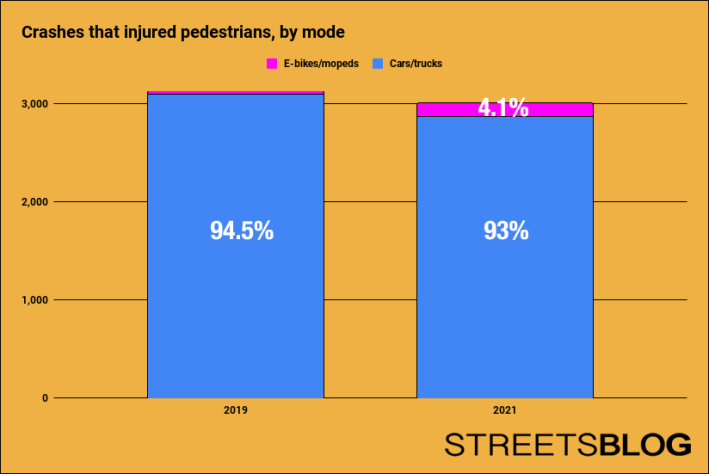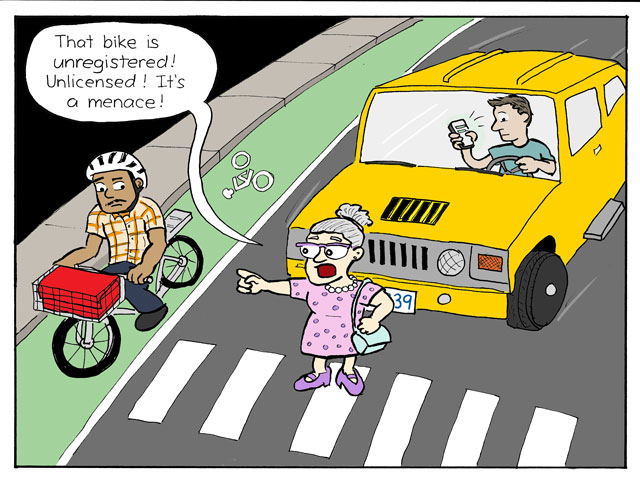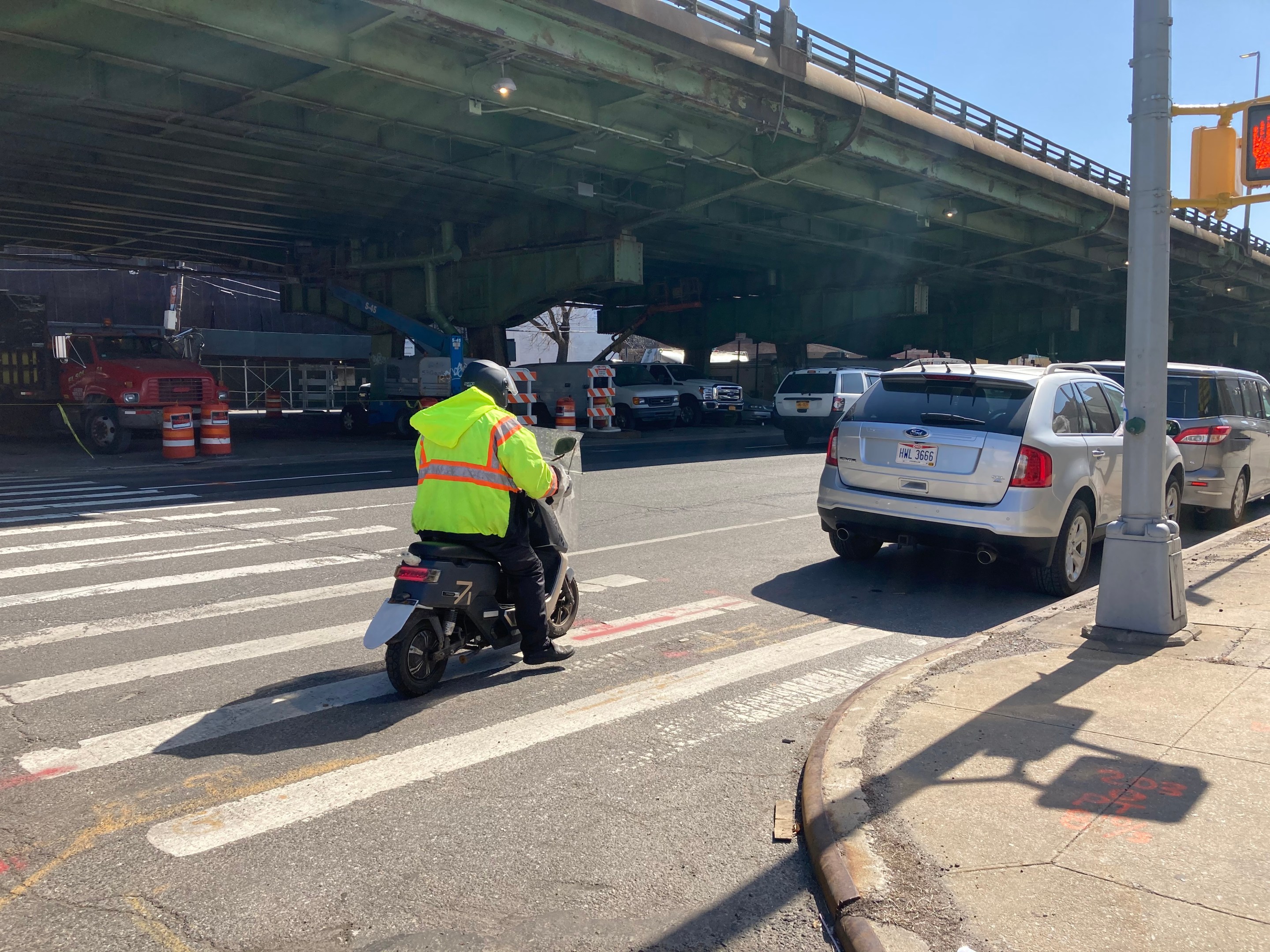No matter how you slice it, the main danger remains car drivers.
State lawmakers comprise the latest group of myopic would-be reformers who are launching a new war on electric bikes and other micromobility modes, but data newly analyzed by Streetsblog shows that for all the talk that e-bikes and mopeds have unleashed a "bloody battle" on pedestrians, the most-violent, least-efficient, most-terrifying vehicles on the roadways are still cars and trucks by far.
First, the news: Borough Park State Sen. Simcha Felder said recently that he nearly hit a cyclist with his car — and then reacted to the terror of the killing power his 3,000-pound car by (wait for it!) introducing new legislation to crack down on bike riders. His bills would require delivery cyclists to wear a helmet; require all cyclists (even users of non-motorized bikes) to get a license and take a driver's ed-style safety course; require all bikes to have a license plate; and require bike riders to carry liability insurance like car drivers.

“Bikes and e-vehicles ... are responsible for a rapidly rising number of catastrophic injuries and fatalities," Felder wrote in an op-ed. (Meanwhile, Felder is also pushing a bill that would help reckless drivers avoid speeding tickets. And he has fought to raise the speed limit on deadly Ocean Parkway, and, earlier this year, voted against the now-stalled Sammy’s Law, which would allow New York City to set its own speed limits without Albany approval.)
Felder's claim that e-bike riders have caused a "bloody battle for pedestrians" is the latest hyperbole regarding moped and e-bike riders that has proliferated this year, most recently after the June death of actor Lisa Banes (“Gone Girl”) who was killed by a hit-and-run moped or e-bike user on Amsterdam Avenue. The NYPD has still not said exactly what vehicle was involved — "unknown scooter" is all the agency has said — leading to the confusion and fear that's caused lawmakers to introduce their respective bills.
Since Banes's death and the death of another pedestrian (in that case, a man who entered a bike lane mid-block and against the light), an Upper West Side community board demanded that the e-bikes, including pedal-assist Citi Bikes, be barred from protected bike lanes. And on the Hudson River Greenway, such bikes are still banned.
Felder and the others are right about one thing: Many pedestrians perceive that they are more endangered, thanks to more and more people using sustainable electric mopeds and e-bikes to get around. The rise of micromobility is a good development that will reduce the city's carbon footprint — but it won't be acceptable to all road users unless it is made safe through street redesigns, automated enforcement and education, advocates have long said.
But are New York City pedestrians actually more endangered now than they were, say, two years ago before Simcha Felder almost killed a cyclist and then decided to wage legislative war on them? Certainly not. Here are the facts (all figures from the city's own collision database):
From Jan. 1 through June 25, 2021, there were 3,101 crashes that led to the injury of a pedestrian. Of those crashes, 2,870, or 93 percent, were caused by the driver of a truck, van, SUV, car or other four-plus-wheeled motor vehicle. Only 132 crashes — or 4 percent — were caused by the users of e-bikes, e-scooters, mopeds or motorscooters (plus all the other words that cops use to classify two-wheeled motored vehicles).
Over the same period in 2019*, there were 3,281 crashes that led to the injury of a pedestrian. Of those crashes, 3,098, or 94 percent, were caused by the driver of a truck, van, SUV, car or other four-plus-wheeled motor vehicle. Only 28 crashes, or less than 1 percent, were caused by a micromobility user.
And crashes involving cars are typically far more violent than those involving cyclists.
Those numbers follow Streetsblog's reporting from 2019, which revealed that e-bike riders caused just 32 — or .05 percent — of all the 61,939 injuries to all road users in 2018.

There has been a slight increase in the number of pedestrian injuries caused by moped and e-bike riders this year compared to 2019*, but there is a simple reason for that: more people are using mopeds and e-bikes because the state legalized them in 2020.
“One possibility for the increase in injuries is the rapid uptake of e-bikes, plus increased demand for e-bikes given [the rise in deliveries during] the pandemic," said Do Lee, an assistant professor of urban studies at Queens College CUNY and an organizer of The Biking Public Project. "This leads to not only many more e-bike riders but also many more inexperienced e-bike riders, who may be more prone to crashes until they become more experienced. Meanwhile, drivers and pedestrians may also have a period of adjustment in accounting for increased e-bikes (and other e-scooters) while in the street."

There's another factor that is driving the fear. Today's debate is being waged by the likes of Felder and community board members with vocabulary that seems to be 10 years outdated (Felder did not respond to our requests for comment). The state law that legalized e-bikes caused a proliferation of a variety of different kinds of electric vehicles, some completely legal, like the throttle-controlled electric bikes that delivery workers historically preferred, and others that are illegal, such as mopeds that can go faster than 20 miles per hour yet do not have the required license plate on them — vehicles that are increasingly becoming the mode of choice for delivery workers because they allow them to cover far more ground, and do it faster. With or without a plate, such vehicles are never legal in a bike lane or a bridge bike path, yet they have been a common sight this year as more people chose a cheaper, sustainable way of getting around only to find themselves required by law to be in the same lanes with 10,000-pound trucks.

City Hall officials have long said they want to support the growth of electric vehicles such as mopeds over cars, but the city is running into a space crunch. Earlier this year, Streetsblog published three stories revealing that at various times during the day, cyclists, e-scooter users and moped riders outnumber or come close to outnumbering cars and trucks on First, Second and Kent avenues. So we asked Mayor de Blasio if the city would consider widening roadways so that moped riders can ride safely — and pedestrians can avoid being surprised by fast-moving vehicles in bike lanes.
"This is a work in progress as always," he said. "We want to keep learning from what people need and what they want. We've been expanding bike lanes intensely all over the city, and if there's more and more bike usage, it makes sense to meet that and address it. So, I'm certainly open. I want to see people as much as possible out of their cars, into mass transit, on bikes, as many options as possible."
No less important is a reckoning with today's demand for fast delivery. A system built on speed and the exploitation of mostly undocumented workers on dangerous roadways is pretty much designed to be unsafe. As the great muckraking journalist Upton Sinclair once observed, it is very difficult to get exploited people to follow the law when their livelihood depends on them not following it. And there is a third partner in this deadly marriage: customers want their linguine alle vongole delivered while it is still hot, yet are removed from the inner workings (indeed, they are protected from it) of how that miracle is achieved on the mean streets. Often, customers never even see the delivery worker, engaging instead with the cold surface of a phone, yet the next morning, will go outside and complain about the first delivery worker they see.
The City Council has a package of bills that could reduce speeding by delivery workers by reducing the incentives they get from third-party apps for speeding; as well as help them make a better living, but even supporters told Streetsblog that the package is merely nibbling at the edges. Changes at the state level — such as legislation to require delivery workers to be real employees rather than gig workers — would truly be the game-changer.
At the same time, delivery worker advocates are concerned that mandating full-time employment would hurt undocumented workers — for whom delivery work is a steady, if demanding, entry-level job in a society built on exploiting the newest arrivals. So don't expect the delivery workers to advocate for themselves.
"Our system makes workers afraid to advocate for better conditions," Lee said. "If we want delivery workers to travel slowly, we need to change their working conditions. It's a fundamental contradiction. Making a profit in capitalism requires people to move faster and faster. You cannot accommodate all these concerns when you have that kind of system."






